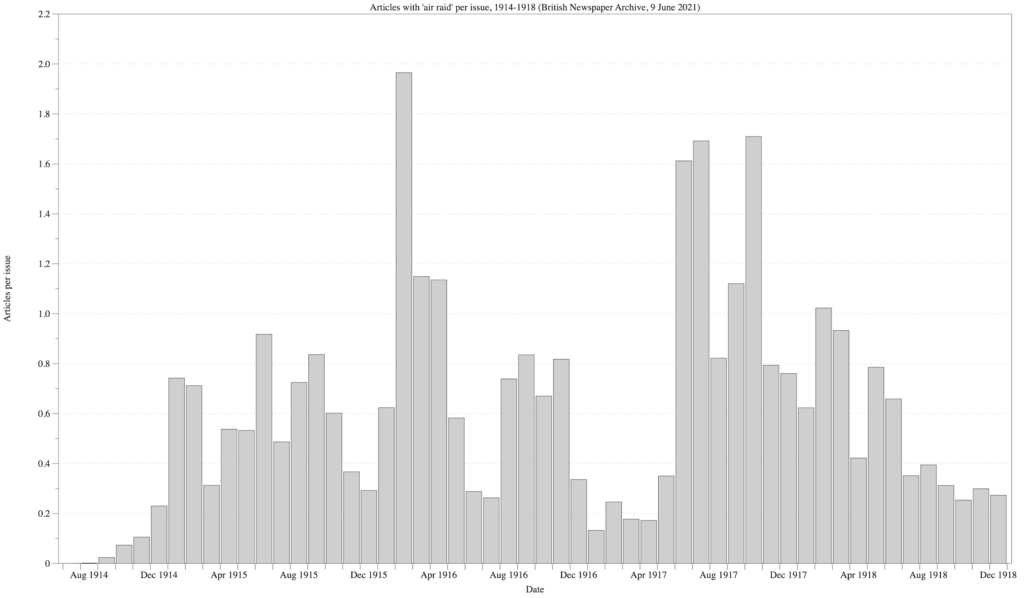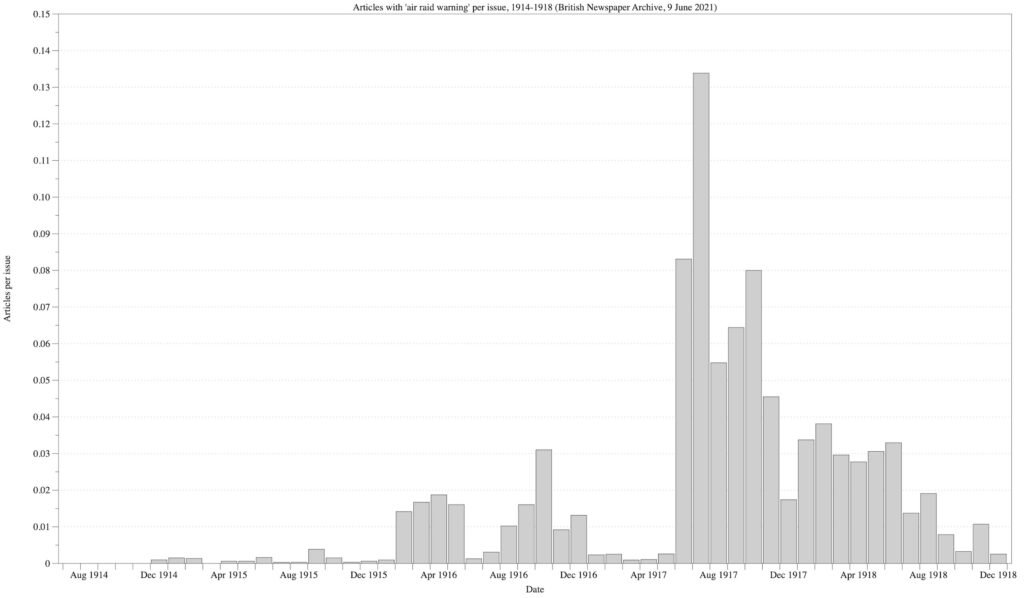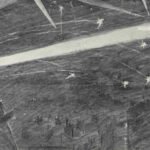
In my previous post I looked at the first appearances of the phrase ‘air raid’ and related words in the British Newspaper Archive (BNA). Of course, just because these phrases had been coined by somebody, or even used in a newspaper, it doesn’t mean they were widely understood — they might have taken a long time to catch on, or even be reinvented independently. So, in order to get a truer sense of how widespread these phrases were, we need to look at some n-grams.
BNA has no Tim Sherratt as yet, so I’ve had to do this manually. But it’s not that hard, just a little laborious. Above is the n-gram for ‘air raid’ between July 1914 and December 1918 (a month beyond either edge of the war, so you can see how much, or how little, difference that made to the frequency). I compiled the raw data for this from a search on the phrase “air raid” (use the double quotes; I don’t bother with the ‘exact search’ checkbox because it’s both too narrow and too broad). On the left side, you get a list of the number of hits — i.e. articles — for each half-century period in BNA. Drill down to the period you want and you can get the number of articles for the time interval you want — here, monthly. That’s your raw data series.
But, you really need to normalise those numbers. The reason for this is that BNA’s holdings (like those of all newspaper archives) are highly variable. Not every newspaper ever published is in there; for those which are in there, not every issue is. For the First World War period, there’s actually a relatively high proportion, because digitisation efforts have focused on that because of the centenary; but then most newspapers shrank and some even folded due to paper scarcity and financial problems. So in order to get a truly comparative sense between, say, August 1914 and November 1918, and make sure you are comparing like with like, you need to compensate for this incompleteness, that is normalise, which means another getting another data series. (As the number of newspapers in BNA changes constantly, do this at the same time as you get your raw data. And record the date.)
One way would be to extract the total number of articles published per interval, and then you can express the proportion containing your keyword as a percentage. The problem with this is that BNA doesn’t tell you what the total number of articles published is — it says it does, but it doesn’t. If you use the method above but just browse by date, you get numbers which are claimed (in a tooltip) to be ‘Articles’, but if you drill down to a single day you can see that the number is actually issues (or editions, but anyway BNA doesn’t do multiple editions from the same day). That’s actually good, though, because you can use this number for normalisation anyway. In some ways it’s better, because it gives you a ‘real world’ figure, the number of times per issue that the keyword appears (averaged across all newspapers in BNA, of course). If you really want to normalise against the total number of articles, not the total number of issues, you can fudge this by searching on a really frequent word such as ‘a’, which will be close enough. (I’ve done this for the plots in this post, and the results are actually not different enough to be worth reduplicating.)
Dividing the raw data by the normalisation data gives you the number of articles per issue. If you like (and I do) you can plot it — I’ve used DataGraph for this.
A final note: ‘article’ seems like a straightforward term. But BNA (necessarily) has to split up a newspaper into articles automatedly and somewhat arbitrarily. Sometimes it joins together different articles; sometimes it splits articles into smaller ones. This happens reasonably often. I’d rather just be able to extract the number of times a keyword appears in an entire issue… but then I remember microfilm newspaper readers and I’m happy with what we have!
Enough of all that. What do these n-grams tell us? The one above (click to enlarge) certainly shows that ‘air raid’ was a common term. In terms of the phases of the air war, this graph suggests that the peak of interest, as far as the press is concerned, was in February 1916, which doesn’t correspond to a peak in ferocity, but it’s when Noel Pemberton-Billing was mounting his very effective by-election campaign on the air defence issue. At this peak, there were an average of nearly two articles (bearing in mind the caveat above) using that phrase in every newspaper issued that month. (In terms of the actual, i.e. unnormalised, numbers that peak represents 5802 articles containing the phrase ‘air raid’, so quite a lot.) The cluster of peaks in the middle of 1917 are almost as high, around 1.6. That’s when the Gotha daylight raids on London took place, the bloodiest of the war, as well as the heavy raids of the autumn. Conversely, at the lowest ebb (after the start of the war, at least) in late 1916 and early 1917, when the Zeppelin menace had been defeated, the figure is more like 0.2, which is not negligible but corresponds to one use of the phrase for every five issues. Generally, the frequency of ‘air raid’ was consistently higher in the Gotha period (mid-1917 onwards) than in the Zeppelin period (Aug 1914-mid 1917).
Here are plots for the other phrases I discussed in the last post, ordered from highest (peak) frequency to lowest, that is, most common to least common.

In terms of peaks, ‘air raid warning’ peaks July 1917, a bit less than a tenth as common as ‘air raid’. Which still seems relatively common. But it was only popular during the Gotha raids (when there were debates about whether warnings should be given, which as it happens I discussed in my book).

The same is true of ‘air raid shelter’, though here the peak (another factor of five down) comes in February 1918, in the last furious gasp of the Gothas.

By contrast, ‘air raid precautions’ has a big spike in February 1916, which is when regulations extending civil defence measures across a wide swathe of the country were announced, and a smaller one in November 1918, when they were finally discontinued. So while its use in this war was surprising (to me, at least), unlike in the late 1930s and early 1940s it doesn’t appear to have been in widespread use.

‘Air raid alarm’ was used, at its peak, only half as often as ‘air raid warning’, a near-synonym; but it was used fairly often from the start of 1916 onwards.

Finally, another similar phrase, ‘air raid siren’, was barely used at all: at its peak, one in every five hundred issues. That’s mainly because sirens were not used universally even when warnings were given, which was not all that often. Policemen or boy scouts were popular alternatives, as were (which I always find staggering) maroons, or in other words, exploding smoke bombs. Which is a good reminder that other terms may have been used, and you need to search around in BNA (or elsewhere) to find them.
That’s all well and good, but I still haven’t explained what I mean by ‘The air raid vanishes’. Next post, for sure!
![]() This work is licensed under a Creative Commons Attribution-NonCommercial-NoDerivatives 4.0 International License.
Permissions beyond the scope of this license may be available at http://airminded.org/copyright/.
This work is licensed under a Creative Commons Attribution-NonCommercial-NoDerivatives 4.0 International License.
Permissions beyond the scope of this license may be available at http://airminded.org/copyright/.




Interesting piece of work, Brett. A couple of observations. The peak in ‘air raid’ in Feb 1916 may be due to the Midlands Raid on night of 31 Jan/1 Feb 1916. This one took the defences by surprise and resulted in the largest casualties to date for a single raid. It gave the ‘papers plenty of copy for some time. In a similar vein, the Feb 1918 peak in ‘air raid shelter’ is probably due to the result of the bomb dropped on the night of 28/29 Jan 1918 by Giant R12 on the Odhams Printing Works – where the basement served as a public shelter. It took six weeks to recover all the bodies so there would no doubt have been regular mentions of the recovery and presumably a reference to the shelter. And just to throw a curve ball in there with ‘Air Raid Siren’ – I quite often come across it spelt ‘syren’ in first-hand accounts.
Best wishes, Ian
Ian:
Thanks for your comment. Yes, you’re right that the February 1916 peak for ‘air raid’ corresponds to the Midlands raid (and in fact upon checking Pemberton Billing doesn’t feature greatly at all, which is interesting too…) You’re right too that Odhams is partly responsible for the February 1918 peak in ‘air raid shelter’, but its actually pretty mixed, and the inquest for the Bishopsgate tube disaster is even more significant (as it was often termed a shelter in the press). Finally, good point about ‘syren’ — it is indeed more common in BNA than ‘air raid siren’ by a factor of 1.5 or 2, though that’s still only a handful of articles in total. But it’s a good reminder that given that I started from the dictionary ‘air raid’, and they are drawn from the Blitz experience, I’m essentially projecting backwards from the 1930s/1940s onto the 1910s, and I need to tread carefully. (One thing I have noticed is that it’s better to drop ‘air’ — ‘raid shelter’ rather than ‘air raid shelter’, for example.)